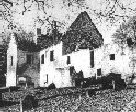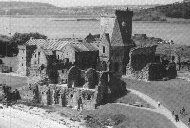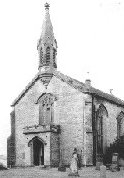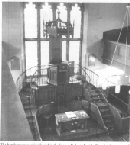
A History of St. Bridget's Kirk
Dalgety, Fife

A village of Dalgety stood at the head of the coastal feature
Dalgety bay, but the ivy-clad ruins of the 12th century St. Bridget's Kirk are
all that now mark its site. The ruins which are maintained by Historic Scotland,
retain many interesting features. The loft remains accessible, and there is a well-preserved 'piscina' by the
altar. A piscina is stone wash-basin for ritual rinsing of the communion
chalice. In the church grounds facing directly onto the shore are a number of
old gravestones and epitaphs.
The loft remains accessible, and there is a well-preserved 'piscina' by the
altar. A piscina is stone wash-basin for ritual rinsing of the communion
chalice. In the church grounds facing directly onto the shore are a number of
old gravestones and epitaphs.
St. Bridget's Kirk was in existence some time before 11 March
1178, as it is mentioned in a Papal Bull written by Pope Alexander III declaring
that "The Church at Dalgetty with its appurtenances" be founded.
 Appropriated at that time by
Inchcolm Abbey, it was consecrated in 1244 by David de Bernham, Bishop of St.
Andrews.
Appropriated at that time by
Inchcolm Abbey, it was consecrated in 1244 by David de Bernham, Bishop of St.
Andrews.
In the aftermath of the Protestant Reformation of the mid
sixteenth century the crown claimed most of the former church lands. In
Morayshire new lordships were created out of the former ecclesiastical estates
and granted, in part, to individuals who had rendered service to the king, a
notable example being Alexander Seton, (1555-1622) who became Commendator of
Pluscarden, Lord President of the Court of Session from 1593 to 1605, thereafter
Lord Chancellor, and latterly Earl of Dunfermline.
Alexander Seton, was the fourth son of George, 7th Lord Seton, and his wife
Isobel, daughter of William Hamilton of Sorn, High Treasurer of Scotland. He
received “ane god-bairne gift” from his god-mother, Mary Queen of Scots, the
lands of Pluscarden. In 1587 the lands of Urquhart and Pluscarden were erected
into a barony and granted to Alexander Seton, which was confirmed on 28 February
1596 by King James VI. Seton was known as Lord Urquhart, later as Lord Fyvie,
and finally as the Earl of Dunfermline. On 6 April 1611 Seton got a charter of
novodamus of the lands and Baronies of Urquhart and Fyvie, the lands of Dalgety
and Danduff, which were all incorporated into the Earldom of Dunfermline and
lordships of Urquhart and Fyvie. Alexander Seton had been one of the most
prominent civil servants during the reign of James VI.
He was succeeded by Charles his son by his third wife Margaret, daughter of Lord
Hay. Charles, born 1608, succeeded his father in 1622. He was a courtier and a
Gentleman of the Bedchamber under Charles I. He also was commander of a Scottish
regiment. Charles, the second Earl of Dunfermline was a Royalist who moved to
Holland after the execution of Charles I in 1649. At the Restoration in 1660 he
became a member of the Privy Council, in 1669 a Lord of Session, and later Lord
Privy Seal. He died in 1672 and was buried at Dalgety House.
He was briefly followed by his second son Alexander as Earl of Dunfermline.
Alexander died unmarried in Edinburgh in 1675 and also was buried at Dalgety
The earldom then fell to his brother James who became the fourth Earl of
Dunfermline. On 25 April 1684 he was granted a charter of the lordship of
Urquhart. However he too was a Royalist and committed to the House of Stuart. He
fought for the Jacobites at the Battle of Killiecrankie in 1689 and consequently
he was outlawed and his title and estates declared forfeit by Parliament in
1690. He fled to the Jacobite Court at St. Germains in Paris, where he was
awarded with the Order of the Thistle. He died there on 26 December 1694.
By the time the Rev. Andrew Donaldson was appointed minister in 1641, the parish was in sore need of pastoral care and attention. Donaldson was soon drafted into the Earl of Dunfermline's army as chaplain and went with the regiment to England. On his return he started work on raising the respectability of the Parish by building a school near the church and insisting on education for all. He worked hard for the poor and examined many people brought before the Kirk Session for failing to live decent and godly lives.
Donaldson was a staunch Presbyterian and refused to attend Presbytery to acknowledge a return to Episcopacy which Charles I was trying to impose on the Church in Scotland. Although the Earl of Dunfermline had given him the Parish for life in 1664, he received letters deposing him from his charge. Because he ignored the order Archbishop Sharp sent soldiers to eject him. Summoned before the Privy Council, he was declared a rebel, became an outcast and as eventually imprisoned in Linlithgow for illegal preaching. Families with whom he had contact were heavily fined (23 families were fined a total of 163 Pounds Scots, about a year's pay per family!). However, the political and religious situation eventually changed and Donaldson was released from prison and reinstated as Minister of the Parish.
Body snatching was a lucrative 'occupation' in those days. Burke and Hare were 'at large' in Edinburgh and supplies of bodies for experiments were always required. Beadles were employed to keep a 'sharp look-out' for body snatchers but were not always effective. There is a small 'keep' built into the wall surrounding the church grounds. Legend has it that some of the 'beadles', rather than protecting the graveyard, would signal at night over the water to Edinburgh when there was a fresh grave at the ancient waterside cemetery.

St. Bridget's was used until the early 19th Century when became unsafe, and in 1830 it was 'unroofed'. A new church built in traditional Scottish 'Gothic' Kirk style and seating 500 was built about half a mile inland. These photographs show the exterior and interior of the 1830 'Old' Church.

In 1843, the Church of Scotland split over a dispute over the distinction between Church and State. The Dalgety minister at the time left for the Church in England and the minister from Aberdour transferred to Dalgety. The population base in the parish had shifted some miles inland towards Fordell and Mossgreen and a church was built there, mainly for the local mining population.
There is a gap in the accurate historical record of the parish, due to a fire in the manse in 1897, which destroyed Session minutes and also the 17th century communion silver plate. The dwindling parish rendered the church in Dalgety uneconomic, and in 1940 it became a linked charge with Aberdour St Fillan's Church. It survived the war and the proximity to the airfield at Donibristle, situated as it was virtually at the end of the main runway.
The first houses of the new settlement at Dalgety Bay were constructed in 1965, and the church link with Aberdour was dissolved. Dalgety Kirk once again stood on its own, serving the ever-increasing population of the new town. The property development expanded west, through the ground of the old airfield and away from the church. It became expensive to maintain and was too small and somewhat marginalised from the new town.
After a great deal of prayer, thought and fund-raising, a new church was built in the centre of the town in 1981. This was extended in 1989, and continues to serve the parish today after more than 800 years.
The record of the Church in Dalgety would not be complete without a mention of the Chapel associated with Donibristle House. Originally a private place of worship for the family of the old house, the chapel today has been preserved, and can still be visited from the footpath off Chapel Villas in the town.
The 80 page book
-- Of Monks and Ministers -- describes in substantial detail the history of the Church in Dalgety. Published by the Church, it is available mail order at only Ј4 (Ј7 outside UK).